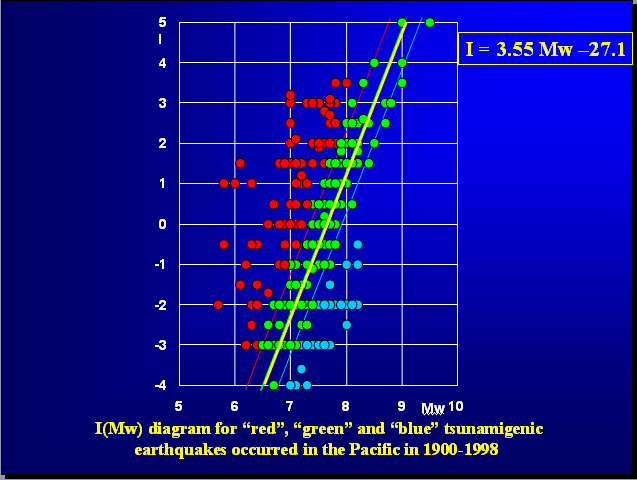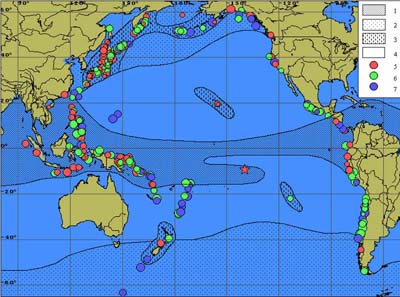|
|
Tsunami General Info
I(Mw) diagram for "red", "green" and "blue" tsunamigenic
earthquakes occurred in the Pacific in 1900-1998

Another study (Gusiakov, 2001) was made to investigate the difference between
the measured tsunami intensity and the expected intensity calculated on the
basis of the moment-magnitude of an event. In the paper (Chubarov, Gusiakov,
1985), the theoretical dependence of the tsunami intensity I on the moment
magnitude of an earthquake Mw has been obtained (I = 3.55Mw - 27.1). This
formula was obtained on the basis of the coseismic bottom displacement model
of the tsunami generation. If we know the actually observed intensity
Iobs, we can estimate the difference dI between the observed and the expected
tsunami intensity (dI = Iobs - Iexp,).
In this study, we have introduced a formal classification of the Pacific
tsunamigenic earthquakes on the basis of their dI parameter. Based on the dI
value, we divided all tsunamigenic earthquakes with known I and Mw into
the three groups: "red" (dI>1), "green" (-1<=dI<=1), and "blue" (dI <-1). From 293 tsunamigenic events that occurred in the Pacific from 1900 to 1998 and which have both I and Mw values, 90 events fall within the "red" group, 153 are within the "green" group and 50 events are within the "blue" group.
The analysis of average magnitudes, source mechanisms, source and water depths, does not indicate to any significant differences between the three selected groups of the Pacific tsunamigenic earthquakes. With a few exceptions, all of these earthquakes are shallow events with typical subduction zone mechanisms; reverse dip-slip or low-angle thrust. However, analysis of their geographical distribution immediately indicates a clear correlation with the climatic and circum-continental zonation in the oceanic sedimentation as described in Lisitsyn (1974, 1988).

|

